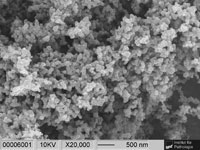| Apr 10, 2006 |
Dangerous duo - ultrafine particles aggravate allergic reactions
|
|
(Nanowerk News) Exposure to ultrafine particles aggravates allergic inflammations in sensitised individuals – especially when exposure to particles occurs before contact with the allergen. Scientists at the GSF – National Research Center for Environment and Health in Germany demonstrate this in a study using a mouse model for allergic airway inflammation, which has just been published in The Journal of Allergy and Clinical Immunology.
|
|
The study, titled "Effects of ultrafine carbon particle inhalation on allergic inflammation of the lung" provides yet another important component in the search for possible links between exposure to environmental pollutants and the occurrence of allergies.
|
 |
Carbon black from burning of diesel (REM photo). (Source: GSF-Institute of Pathology)
|
|
A number of epidemiological and clinical studies have shown an association between increased ambient air particle concentration and adverse respiratory and cardiovascular health effects, leading to enhanced mortality rates as well as to exacerbation of respiratory morbidity. In the April 2006 issue of the Journal of Allergy and Clinical Immunology, Dr. Alessandrini and colleagues from the Clinical Cooperation Group Environmental Dermatology and Allergology (UDA) of the GSF investigate potential adjuvant activity of inhaled elemental carbon ultrafine particles on allergic airway inflammation.
|
|
"Our assumption was", says Alessandrini, "that it is particularly the ultrafine carbon particles, that have an aggravating effect on allergen induced airway inflammation". The study was carried out in close cooperation with colleagues from the GSF Institute of Inhalation Biology, whose long term expertise contributed to the study.
|
|
Sensitised mice inhaled different concentrations of ultrafine carbon particles at different intervals before and after exposure to allergen. Following this the scientists documented the allergic airway inflammation at different time points after allergen exposure. To do so they recorded concentrations of cytokines (e.g. IL-4, IL-5, IL-13) and numbers of inflammatory cells (e.g. neutrophils, eosinophils) in lavage fluid from lungs and compared the results with allergen challenged animals that had not been exposed to particles.
|
|
The results were clear cut: exposure to ultrafine carbon particles 24 hours before allergen challenge resulted in a significant increase in inflammatory markers compared to the control animals. The effects were dose and time dependent and could even be demonstrated, when the particles had been inhaled as many as four days before allergen exposure. They were also accompanied by elevated mucus production and increased reactivity of the respiratory system. In contrast, only moderate effects were observed, when particle exposure occurred after allergen contact, suggesting that the sequence of events is crucial.
|
|
"Our results suggest that allergen-sensitized individuals are more susceptible to detrimental health effects of ultrafine particles" the scientists sum up the findings of their investigations.
|
|
The study strongly supports the concept that allergic sensitization represents a susceptibility factor for the effects of ultrafine particles on allergen induced airway inflammation. The results are the outcome of an interdisciplinary approach of GSF scientists from clinical and basic science laboratory groups. This cooperation is made possible in the project field "Relevance of Aerosols to Health", which was established in 2002 by the GSF, to which several institutes and project groups contribute their expertise, in order to allow a complex risk analysis of inhaled particles.
|

